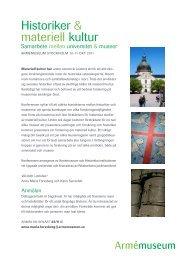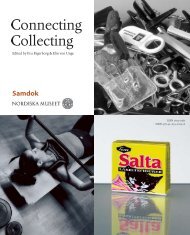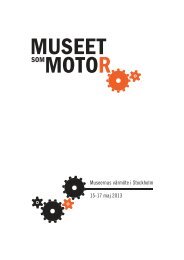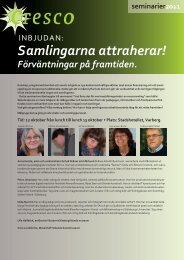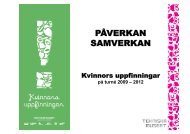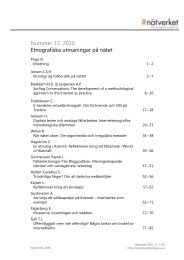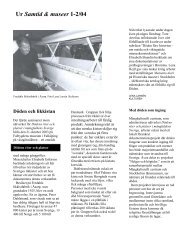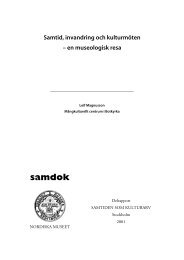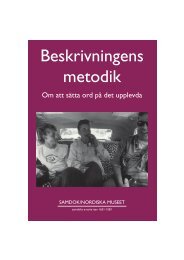Connecting Collecting - Sveriges Museer
Connecting Collecting - Sveriges Museer
Connecting Collecting - Sveriges Museer
Create successful ePaper yourself
Turn your PDF publications into a flip-book with our unique Google optimized e-Paper software.
The Pool for Sami Lifemuseum, Sámiid Vuorká-Dávvirat, andthe adjacent tourist attraction SápmiPark. There were lively and interestingdiscussions about how a traditionalmuseum and an experience centre witha multimedia programme, a large souvenirdepartment, and a restaurant couldcooperate.Field studiesThe pool members represent ethnic,multicultural, regional, and national perspectivesand linguistic and ethnologicalresearch. This span, which is alsogeographical, gives the group a broadorientation which means that Sami issuescan be viewed from different perspectives.The members work in differentways with matters concerning Samilife: through fieldwork and collecting,exhibitions, courses, lectures, and otheractivities. Over the years the projectshave dealt with the world heritage siteof Laponia, with reindeer herding, dress,handicraft, and language, the everydaylife of Sami women, and Sami schools.In Umeå the museum, through a studycircle, has engaged various organizationsto shed light on Sami life in theFrom the pool’sfield trip to Sápmiin September 2005.Signpost in Karesuandoon the Swedish-Finnish border, in themidst of the world:11,636 km to Lima,6,269 to Calgary.Photo: Eva Silvén©Nordiska museet.city over time, by collecting historicalmaterial from the old days parallel topresent-day interviews. By continuousacquisition of artefacts, Ájtte has documentedthe change in the range of waressold at the annual Jokkmokk market.In August 2007 pool members tookpart in a joint workshop/field seminartogether with representatives of otherSamdok pools. The aim was to arrive atmore profound knowledge of what lifeis like today in a small place in the Västerbottenmountains, Ammarnäs. Differenteconomic activities are representedin the community, such as tourism,trade, hunting, fishing, reindeer herding,and handicraft. The participants in theseminar had the opportunity to interviewlocal people, to make study tours andbe guided in the surroundings. We hopethat it will be possible to present the resultin some form in collaboration withthe local community council, so that theinhabitants of the place will be able tobenefit from the work.Crossing bordersIt goes without saying that the Sami aspectis not a variable that stands alonein the pool’s studies; depending on thesubject it is combined with other powerfactors such as gender and class, butalso ethnicity in a broader sense. At thesame time, the Sami aspect can in itselfbe described as multi-perspectival inthat it includes so many different interfaces,cultural encounters, and culturalconstructions – regionally, nationally,and internationally, as well as in relationto different cultural-heritage andresearch institutions. Borders are alsocrossed in time, between then and now:history is invoked in trials about landrights, while handicraft and languagelink past and present in new forms –which the pool aims to explore throughcontemporary fieldwork and exhibitions.The museums’ collections are anotherhistorical phenomenon that is highlytopical today and charged with presentdaymeanings. Through inventories anddemands for repatriation the collectionsare given an active role in coming toterms with the colonial heritage, bothnationally and internationally.The global indigenous policy, whichhas a place for instance in the variousorganizations of the United Nations,creates a new framework and a newcontext for Sami issues at all levels, inthe museums as well. New affiliations,meanings, and forms of understandingarise, also forcing the museums to altertheir perspective. But for anyone who isinterested in following a societal changein real time, studying how a new powerorder is established, these movementsand currents are also an object of studyin themselves. pAnne Murray is curator at the Museum ofEthnography, anne.murray@etnografiska.seEva Silvén is curator at the Nordiska Museet,eva.silven@nordiskamuseet.seSamtid & museer no 2/07 • 21



